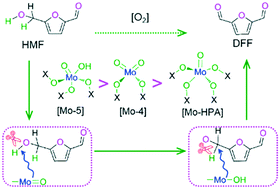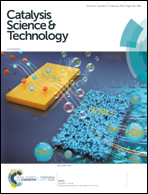The design and catalytic performance of molybdenum active sites on an MCM-41 framework for the aerobic oxidation of 5-hydroxymethylfurfural to 2,5-diformylfuran†
Abstract
Mo-Containing catalysts exhibit good catalytic performance toward the selective oxidation of platform chemicals from biomass. However, for the aerobic oxidation of 5-hydroxymethylfurfural (HMF) to 2,5-diformylfuran (DFF), the development of an environmentally-friendly and promising catalytic system remains a significant challenge to date. In the present study, on the pore surface of MCM-41, two kinds of active sites, which are, –(SiO)2Mo(O)2 ([Mo-4]) and –(SiO)3Mo(OH)(O) ([Mo-5]), have been theoretically designed, over which the catalytic mechanisms for the aerobic oxidation of HMF to DFF have been theoretically examined, combining the hybrid quantum mechanics and molecular mechanics calculations. Over both [Mo-4] and [Mo-5] active sites, the oxidative reaction includes two main reaction steps, the O–H and C–H bond cleavages of HMF, in which the crucial reaction step is associated with the C–H bond cleavage of the CH2 group of the first HMF. Over the –(O)4–Mo![[double bond, length as m-dash]](https://www.rsc.org/images/entities/char_e001.gif) O active site on the Keggin heteropolyacid ([Mo-HPA]), [Mo-4] and [Mo-5] active sites, the Mo
O active site on the Keggin heteropolyacid ([Mo-HPA]), [Mo-4] and [Mo-5] active sites, the Mo![[double bond, length as m-dash]](https://www.rsc.org/images/entities/char_e001.gif) O group is responsible for the O–H bond activation in the HMF moiety, and the Mo–OH group is in charge of the C–H bond activation in the HMF moiety, both of which take a synergic catalytic effect. The catalytic activity decreases as [Mo-5] > [Mo-4] > [Mo-HPA]. Based on the activation strain analysis, the lowering activation energy stems mainly from the lowering activation strain of the active site, which correlates positively with the corresponding HOMO–LUMO gap. These findings provide deep insight for the rational design of a recyclable catalyst to activate both C–H and O–H bonds at low temperatures, especially for some typical platform molecules from biomass.
O group is responsible for the O–H bond activation in the HMF moiety, and the Mo–OH group is in charge of the C–H bond activation in the HMF moiety, both of which take a synergic catalytic effect. The catalytic activity decreases as [Mo-5] > [Mo-4] > [Mo-HPA]. Based on the activation strain analysis, the lowering activation energy stems mainly from the lowering activation strain of the active site, which correlates positively with the corresponding HOMO–LUMO gap. These findings provide deep insight for the rational design of a recyclable catalyst to activate both C–H and O–H bonds at low temperatures, especially for some typical platform molecules from biomass.



 Please wait while we load your content...
Please wait while we load your content...